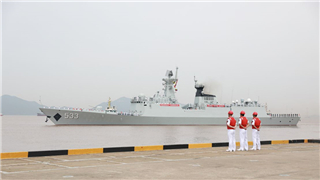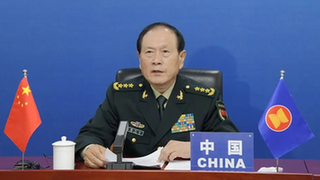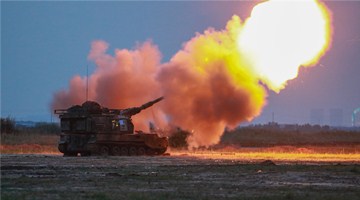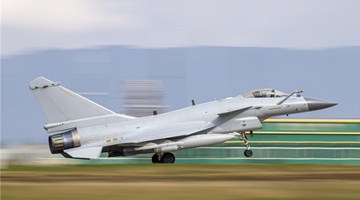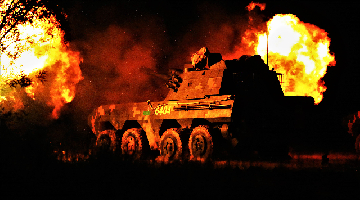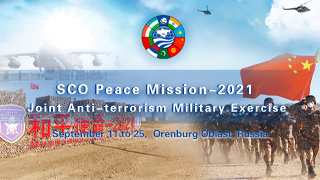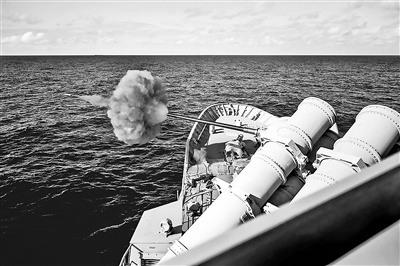
File photo: A ship conducts live-fire drills during the Rim of the Pacific exercise led by the US.
The US military has carried out intensive training activities in the Indo-Pacific region since June. On June 2, the Navy of the US Indo-Pacific Command and the South Korean Navy held a joint maritime exercise on the high seas near Okinawa, Japan. On June 6, the US launched a large-scale exercise Valiant Shield 22. On June 8, the 3rd Marine Expeditionary Brigade of the US Marine Corps stationed in Japan held a crisis response exercise. On June 15, the 199th Fighter Squadron stationed in Hawaii flew to Japan to conduct joint training with the Japanese Air Self-Defense Force. On, June 29, The Rim of the Pacific 2022 (RIMPAC 2022) exercise kicked off in Hawaii.
In fact, the US military stationed in the Indo-Pacific holds more than 90 code-named drills with the military of countries in the region every year. The common goal of these exercises is to maintain US hegemony in the Indo-Pacific region.
In recent years, in response to the so-called "majorcountries’ competition", the US has paid more attention to using the strength of its allies and partners to balance China and Russia. Controlling allies and influencing partners through joint exercises and training to build a US-led Indo-Pacific security order has become an important choice for the US to maintain its hegemony.
On the one hand, the US has firmly grasped its traditional allies and strengthened its internal cohesion. In the past few years, the US and Japan, Australia, the ROK, the Philippines, Thailand, and other allies have carried out all-round, multi-domain, high-frequency joint exercises and training. The US intends to tie Japan and Australia to the American chariot through military integration and curb the centrifugal tendency of the three countries of the ROK, the Philippines, and Thailand.
On the other hand, the US is actively expanding its partnership network and enhancing its capability to shape the Indo-Pacific region. To "focus on every corner of the Indo-Pacific", the US has conducted joint exercises and training with traditionally undervalued regional countries in South Asia, Southeast Asia, and the South Pacific. The US also took this opportunity to install a field information support communication system in maritime command centers in several Southeast Asian countries and integrated the maritime monitoring networks of these Southeast Asian countries into the US Indo-Pacific combat system. The US has also dispatched training advisory groups to Papua New Guinea, Fiji, Tonga, and other South Pacific Island countries to guide and organize training and urge them to rely on the US in the military field and recognize the US in terms of values.
In addition, the US has also brought in NATO allies to strengthen its presence in the Indo-Pacific region. In recent years, a "small multilateral" joint training model has emerged in the Indo-Pacific region, led by US Indo-Pacific allies, and participated by several NATO countries. In such drills, several NATO countries including the UK, France and Canada dispatched small ship formations to the Indo-Pacific region to participate in the drill and show a posture of supporting the US for their own interests.
In recent years, the US has deployed its Army brigade combat teams to relevant Indo-Pacific countries through rotational training, so that they can learn about the local natural environment, customs, and friendly forces. The large-scale training activities carried out by the US military in the South China Sea and surrounding areas are also intended to collect environmental data and information such as meteorology, hydrology, seabed geology, and topography in the South China Sea in addition to deterring China. US activities in the Indo-Pacific region are all close-in training to get familiar with the preset battlefield environment.
The current US competition with China is to use joint exercises and training to attract allies and establish exclusive "small circles" to create divisions and confrontations between countries. The anti-China military group formed by the US has the fundamental purpose to bring the Asia-Pacific region into the trap of geopolitical games and camp confrontation so that the US can reap the benefits.
Drills including the US-Japan remote island defense exercise, the US-India alpine mountain exercise, and the US-Philippines joint island control exercise clearly point to disputes over territorial sovereignty and maritime rights and interests between these countries and China. By imparting combat skills and strengthening information sharing, the US has encouraged relevant countries to confront China. If not curbed, such practices of intensifying contradictions and inciting confrontation are likely to weaken the foundation of long-term peace and stability in the Asia-Pacific region and seriously affect regional peace, stability, development, and prosperity.

